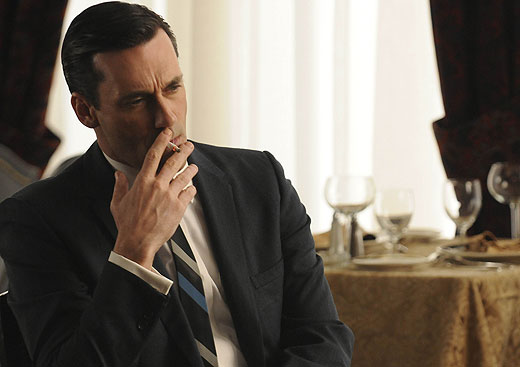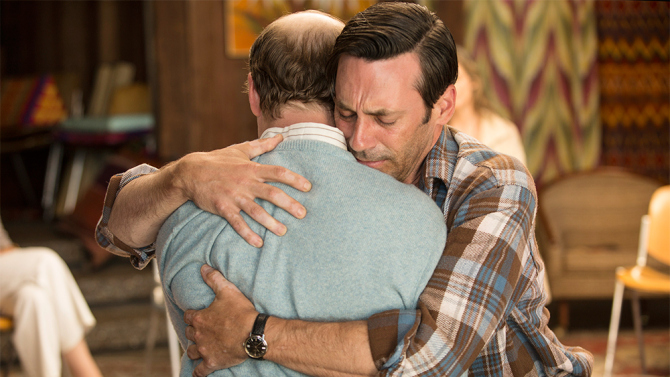BOOKENDS: We are all Don Draper (the pilot and series finale of Mad Men)
Here’s a character arc we can all understand:
From blocked creative to fulfilled creative.
You know this story.
You’re young and it comes easy. It flows out of you. You get a bit older and it starts to feel more like work. Life intercedes, your creative side suffers, and you struggle. You hit the wall and you feel like you just can’t do it anymore. You’re blocked, stuck in the crucible, and it seems like there’s no escape. You contemplate giving up, throwing in the towel. It would be easier to just call it a day — it would alleviate a lot of pain. But you can’t. You have to keep fighting. You have to do the work. So you make a plan. First, you strip yourself of all that is holding you back. You get lean and mean. You do the work. It’s the only way. The only way to find your new path back to creative fulfillment. And one day it comes to you: that big idea. The lightbulb that illuminates that corner of your imagination that had been held in shadow for so long. Maybe it’s just the idea that gets you back at the desk, or maybe it’s a world-class winner of a concept that lights a fire across the globe.
This is your story. The story of every writer.
And, as we now know, it is the story of Don Draper, the now iconic character at the heart of Matthew Weiner’s Mad Men.
We are all Don Draper.
Just with less mistresses and whiskey.
I hope.
With Mad Men ending, a wave of ground-breaking dramas comes to a close. I think of this wave as the Act Two of the “New Golden Age” of television that we’ve heard so much about in recent years. This wave rose as the shows in Act One were coming to a close, shows like The Sopranos, The Wire, Deadwood, The Shield, and Battlestar Galactica. Mad Men’s wave included Breaking Bad, Lost, and Dexter, and, like those shows, it was shaped in part by the economic impact of the WGA writer’s strike of 2007-2008. (Alan Sepinwall’s excellent book The Revolution Was Televised provides a detailed history of this era) The current wave (Act Three?) includes Game of Thrones, The Walking Dead, Downton Abbey, The Good Wife and Homeland. I’m sure the endings of those series will receive much fanfare, as well.
When you watch a series finale, one can’t help but think back to the pilot episode. You hope for a nod to the pilot, knowing that only a true fan like you will catch it. If the pilot was the beginning and the series finale is the end, you look at those two episodes as the bookends that hold every episode in-between. The writers in the writer’s room are doing the same thing, knowing that fans like you are out there, hoping for some acknowledgement of their dedication to this years-long journey.
It is tempting to look for connections between the two poles, starting with structure. The first technique to look for would be “mirroring,” in which the order and basic structure of scenes in the finale are played in reverse order from the pilot. A simple example of this would be Lost: the pilot begins with Jack’s eye opening and the series ends with Jack’s eye closing.
SPOILERS FOR “MAD MEN” SERIES FINALE AHEAD
Similarly, yet less obviously, the Mad Men pilot opens on Don struggling to come up with an ad campaign and the finale ends on what we can presume is his greatest creation: the famous Coca-Cola “Hilltop” commercial from 1971 (I’d like to buy the world a Coke…). Don’s long struggle to find himself leads him to the seemingly obvious conclusion that he is an ad man at heart. The answer may be simple, but it was incredibly hard for him to see it. It took him years to come to terms with it, to own it.
It’s easy to forget that Don was always a writer, plain and simple, and ad campaigns were his chosen medium. But since he created his career from whole cloth, and never had any kind of formal education, he always held a massive insecurity just under the surface, invisible to all but a certain few who were able to penetrate his thick, fabricated skin. Like all of us, he had to redefine his approach to the craft as he aged.
But Mad Men is not just Don’s story. While the pilot focused on Don, the series finale required more plot threads (B, C, D and E stories) because the supporting characters had developed so much over the course of seven seasons. For example, Joan Holloway only gets a couple short scenes in the pilot as her function is merely to give Peggy (the “Newborn”) a tour of the Sterling Cooper offices, but by the time we’ve reached the finale, her story demands closure on three fronts: her love interest, her child and her career.
There are about 20 scenes in the pilot and approximately 28 in the finale. Four acts in the pilot and five acts in the finale. Just as the narrative developed, turned and expanded over seven seasons, the finale reflects this with a more complicated structure than the pilot.
It’s interesting to note the various changes in status. Joan is definitely Peggy’s superior in the pilot, and in the finale she tries to recruit Peggy to join her as an equal partner in a new production company which she proposes should be called “Harris-Olson” because “you need two names to make it sound real.” By the end, Joan is in business with her two names, except they are both hers: “Holloway” and “Harris.” (Her maiden and married surnames.) She has found the strength to strike out on her own (sans unsupportive boyfriend, who she ditched a couple scenes prior).
Peggy’s love life had always suffered because of her dedication to work. She never met a man who stacked up to her job. We leave her as she has successfully integrated the two by getting together with her co-worker, Stan. She types away as he stands behind her, literally backing her up in her pursuit of her career.
Betty and her daughter Sally, always in conflict, have essentially switched places, with Sally as the matriarch of the family now that Betty is dying.
Pete and Trudy Campbell, the quintessential Manhattan couple, have decided to start over in Wichita, Kansas. They’re not exactly becoming corn farmers – they’re last seen boarding a Lear jet – but they are bound to encounter some culture shock when they arrive.
Don led many a meeting of subordinates with an air of authority, often arrogance, but his penultimate scene in the finale finds him sobbing in the arms of a stranger; the very type of “normal” guy that Don’s team had assumed was a sheep to their brilliant powers of persuasion. Don is shocked to learn that this nebbish has the exact same damaged psyche that he does.
Roger Sterling has perhaps the most shocking arc of all. He settles down with a woman of his own age!
It’s not easy for me to say goodbye to these characters. My wife and I have watched every episode of Mad Men at least three times. We even had the opportunity to meet and interview many members of the cast (see Youtube link below). Matthew Weiner and his creative team have given us all a master class in serialized filmmaking that will stand the test of time. I know the show is not everyone’s cup of tea, but for dramatic writers, there is so much to learn by studying the craft of Mad Men.
As for me, I’ll be here waiting for Ken Cosgrove’s book about his adventures in the ad trade.
Good luck and happy writing,
Dan






Leave a Reply
Want to join the discussion?Feel free to contribute!